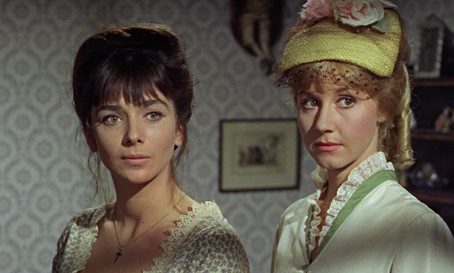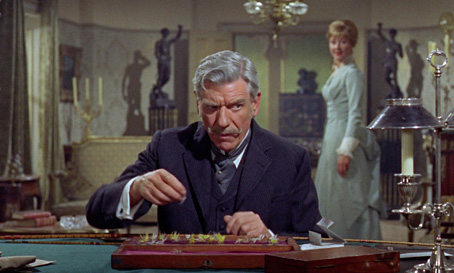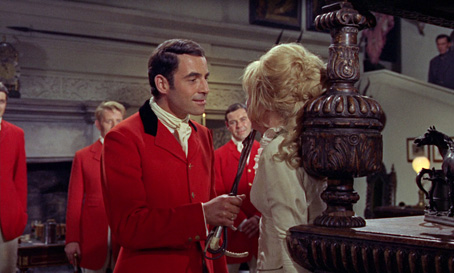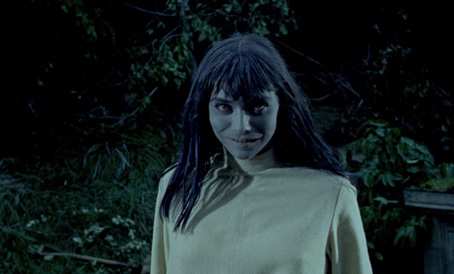"Zombie!" |
Sir James Forbes reacts succinctly to
the sight of human reanimation |
Director John Gilling has a special place in the hearts of fans of Hammer's unique brand of horror, specifically for two consecutively shot films released in 1966 that showcase at the studio at close to its best. Plague of the Zombies and The Reptile can be seen now as stylistic companion pieces, sharing sets and locations and the same basic set-up (an outsider investigates strange goings-on in the quiet Cornish town in which a friend or relative is or was a resident), and even two key supporting players. Watch them together, as their simultaneous Blu-ray release enables (and, let's face it, quietly encourages), and you become very aware of the similarities between them and are left with the impression that this small corner of Cornwall could well be the unluckiest place on earth. But they were never designed to be seen this way. Originally part of a four-film plan to cut down costs by recycling elements and shooting back-to-back, two months separated the release of both films and they originally played as supporting features to Dracula: Prince of Darkness and Rasputin the Mad Monk, the other two movies in this money-saving scheme. And recycling props and settings was as natural to the frugal Hammer is it was to Roger Corman when shooting his Poe adaptations, while some actors appeared in enough Hammer films to have become almost synonymous with the studio's output. Michael Ripper holds the record, appearing in a staggering twenty-three films for the studio, Plague of the Zombies and The Reptile included. And let's be honest, who wouldn't want to re-employ a young actress named Jacqueline Pearce after her brief but captivating debut here?

Ah, Jacqueline Pearce. Back in the late 70s, the key focus of UK geek fandom was not Star Trek but Blake's 7. Yes, the sets were wobbly and the effects sometimes unconvincing, but spare a thought for the enterprising Matt Irving, who was required to create the all the models and effects on a budget that wouldn't even cover a day's catering now. And what the show lacked in technical polish it more than made up for in story, dialogue and distinctive characters. In many ways it played like Star Trek's nefarious and financially strapped younger brother – where Trek chronicled the adventures of a group of noble representatives of the United Federation of Planets, the heroes of Blake's 7 were criminals, fugitives and would-be revolutionaries. And where Star Trek had Captain James Tiberius Kirk, adventurer, humanitarian, womaniser and cheeky rule breaker, Blake's 7 had Kerr Avon, computer expert, profiteer, and a man who would probably throw his own mother to the wolves in pursuit of personal or financial gain. If he ever had a mother, which we tended to doubt. It's thus perhaps typical of the series that it's villains were every bit as interesting as its antiheroes, and leading the opposition was Federation Supreme Commander Servalan, a role brought deliciously to life by Jacqueline Pearce. And we were all in love with her. With her wide cat-like eyes, her close-cropped hair, her deep cultured voice and her flamboyant and suggestive dress sense, she symbolised everything that was exciting about dangerous women. She toyed with people in her pursuit of greater power and disposed of them when they were no longer of use to her, and did so with the sort of self-satisfied smile that made you want to volunteer to be next on her hit list. For the geeks of my day, Jacqueline Pearce was akin to a goddess. Only later did I discover that she'd been in two of the smartest horror movies of the mid-1960s, which is a weeny bit embarrassing as I'd actually seen one of them a few years before. But I was young when I first caught it and all this time later my memories were hazy, yet I was still able to recall one sequence vividly. I'll get to that later.
Plague of the Zombies plays the sort of inventive games with the concept of zombification that you rarely see now that the zombie movie has become a fully-fledged sub-genre. Brought back to life by Caribbean witchcraft, the white eyed, grey skinned creatures of the title sit somewhere between the voodoo-revived corpses of 1940s Val Lewton and the living dead to come of George Romero and his army of imitators. The mystery here is not what is happening – a pre-title sequence confirms voodoo is at work in this small Cornish town and reveals who it's being used on – but why local people are being systematically led to their deaths and transformed into undead shells of their former selves.

On his way to investigate, after receiving an ominous note from his former pupil Peter, is eminent surgeon Sir James Forbes, accompanied by his daughter Sylvia, who jumps at the chance to visit to her old friend Alice, who is now Peter's wife. Sir James is the sort of bluff, old-school gent of military bearing who, as played by the splendid André Morell, you can't help liking in spite of his conservative demeanour. His relationship with his daughter is neatly and economically established when she briskly decides they should travel to Cornwall and he dryly suggests he should have drowned her at birth, which the jaunty Alice brushes off with a knowing grin as she heads off to pack. As they near their destination, their coach is brought to a stop by an aggressively rude huntsman and his ghastly brood, whom Sylvia misdirects because she sympathises with their prey, as we all tend to do when faced with what Oscar Wilde memorably described as "the unthinkable chasing the uneatable." A funeral greets the pair as they arrive in town, which is disrupted when the unthinkables barge through the procession to berate the young Sylvia for spoiling their fun, causing the coffin to topple and expose the corpse within. What a bunch of bastards. You don't know the half of it.
When Sir James and Sylvia arrive at Peter's house they are greeted at the door by a perpetually nervous Alice, who initially fails to recognise her childhood friend. Peter tells Sir James about the mysterious plague that is killing the townspeople and the refusal of local coroner and magistrate Squire Hamilton to grant him permission to autopsy the bodies. Sir James' elegant solution is to nip down to the graveyard and dig one up – that unfortunate fellow whose coffin was toppled by the unthinkable huntsmen should be fresh enough. The pair thus get to work and have just dug down far enough to unearth the coffin when Sir James looks up and, in what may well be the most comically perfect edit in the entire Hammer film canon, we cut to the figure of two motionless policemen stonily observing these nocturnal labours. Arrest appears imminent, but when Sir James reveals that the coffin is empty, Sergeant Jack Swift (a typcially fine Michael Ripper) agrees to help them investigate, his son having been one of the first to die.

Sylvia, meanwhile, sees Alice leave the house in the dead of night and immediately gives chase. Before she can reach her she's harassed and kidnapped by the unthinkable huntsmen, who cart her back to Hamilton Hall and, in what must be one of the most implicitly unpleasant scenes in any Hammer film of the period, laughingly toy with her and then cut cards to see who will go first in what is clearly an intended gang rape. Fortunately for Sylvia, it's brought sharply to a halt by the arrival of a furious Squire Hamilton, whose profuse apologies for his men's behaviour fall on defiantly deaf ears. Refusing the proffered loan of Hamilton's carriage, Sylvia heads home on foot, but loses her way and finds herself at a tin mine where a zombie throws Alice's body at her feet.
Plague of the Zombies is without question one of Hammer's most accomplished and rewarding films, one whose smart story development, typically brisk pacing and keenly defined characters (I can't be the only one who quite fancies the idea of a series of adventures featuring Sir James) are further enriched by its pre-empting of elements that would later define the genre, as well as some surprisingly overt political overtones. This is not the sort of interpretive reading from which essays on the sexuality of Dracula or the Freudianism of The Mummy have grown, but an open critique of the rank immorality and ruthless self-interest of the privileged classes. As represented by Squire Hamilton and his band of unthinkables, they bust up a funeral because they didn't catch a fox, amuse themselves by kidnapping and attempting to rape a woman, and kill and exploit the poor (in that order, no less) for no other reason than to line their over-privileged pockets. As a modern day social parable, it couldn't be more relevant.
But the scene that haunted me for so many years and which still makes me shudder when I watch it today is a two-parter set in the village graveyard at night. Having established that all of the corpses have been stolen for nefarious purpose, Sir James and Peter choose to keep vigil by Alice's grave. They nearly blow it when they're deliberately distracted by an assault on the vicar they've just sent on his way, but return just in time both to prevent a gaggle of masked grave robbers from snatching Alice's body and to witness her unholy resurrection, a bone-chilling sequence made all the more effective by Gilling's canny camera placement and Pearce's movements and facial expressions. Honestly, when she walks towards the camera and her tight-lipped determination flickers into a malevolent smile, I let out a small and uncontrolled yelp of horror. But it's the sequence that follows that everyone remembers, as reality dovetails invisibly into a dream in which the zombified dead claw out of their graves and advance on Peter with murderous intent. Not only is this spectacularly well handled, with nervously hand-held camerawork, twisted angles and James Bernard's score creating a very real sense of disorientated nightmare, it foreshadows and frankly outclasses any number of similar scenes in the still ongoing post-Romero zombie cycle.

Plague of the Zombies was always one of my favourite Hammer movies, and watching it again after a gap of a few years has done nothing to diminish its power and standing. With current zombie movies caught in a cycle of repetition and restrictive formula (see Gort's review for Apocalypse of the Dead for a breakdown), Plague of the Zombies shines even today as a true original, both within the realms of zombie horror and Hammer's own catalogue of monster-led features.
Carefully restored by the good people at Pinewood, the film looks better here than I could ever have hoped. There is, of course, no reason whatsoever why it shouldn't look great – it was, after all, shot on 35mm DeLuxe colour stock on well lit interiors and sunlit exteriors (even the night scenes). But after years of watching shoddy quality transfers of Hammer classics on late-night TV, to see one of your favourites looking this good is genuinely heartwarming. The image is consistently vibrant and the colours well rendered, within the restrictions imposed by the film stock, which has a distinctive warm look that nails it to the late 50s to mid-60s, though prime colours shine when required to so so (the red of blood in particular pops out of the screen). The contrast is excellent and the sharpness and picture detail leave no doubt at all that we're watching a Blu-ray transfer. Grain is visible, more so in a few of the darker scenes, although most of these have been shot using day-for-night (see the footnote on Dracula: Prince of Darkness for more on this process) and are sometimes brighter than were possibly intended. In the accompanying documentary, restoration manager Jon Mann pre-empts such criticism by assuring us that this long after the release it's a judgement call as to how much the picture should be darkened on the day-for-night footage, and I have to admit that some of the shots that seemed a little too bright on my plasma TV looked spot-on when viewed on a computer monitor. If there's a dust spot left I must have blinked and missed it, and the complete lack of damage seems all the more miraculous when you hear what Mann has to say about the condition of the source material.
The PCM linear mono track has also been very effectively cleaned up, providing clear dialogue, distortion-free music and effects, and not a trace of background hiss.
Raising the Dead (34:01)
A newly made and enjoyable appreciation of the film, featuring interviews with Hammer Film historian Marcus Hearne, genre fan Mark Gatiss, actors John Carson (who plays Squire Hamilton and admits he sounds like James Mason) and Jacqueline Pearce (hoorah!), the film's art director Don Mingaye, and writer on Hammer Films Wayne Kinsey, amongst others. Pinewood's Technical Restoration Manager Jon Mann is once again on hand to talk about the restoration and reveals that of all the Hammer films they have so far restored, the negative for this one was in the worst condition.
World of Hammer Episode: Mummies, Werewolves and the Living Dead (24:49)
Oliver Reed narrates us through another set of lengthy clips from the Hammer portfolio, this time with the focus on the monsters of the title. Films covered include Legend of the Seven Golden Vampires, all four of studio's Mummy movies (including the excellen, Seth Holt directed Blood From the Mummy's Tomb), Captain Clegg (in which Oliver Reed appears), The Curse of the Werewolf (Reed again), and, of course, Plague of the Zombies. It should be noted that if you've yet to see any of these films, there are some serious spoilers here, including two finales.
Restoration comparison (4:32)
Side-by-side examples of the film before and after the restoration, and as with the one on Dracula: Prince of Darkness, the 'before' footage appears to have been drastically lightened to clearly differentiate if from the finished product.
Trailer (1:55)
Terror! Death! Drums! Not in great shape, but intriguing nonetheless.
Tightly plotted and directed, and with smarter than average dialogue by Brides of Dracula writer Peter Bryan and a splendid central performance from André Morell, Plague of the Zombies is one of Hammer's best works and a rare example of 60s film horror that still has the power to chill today. It's an unexpected but welcome early choice for Studiocanal's ongoing project with Pinewood Studios to restore Hammer films to near pristine condition. And as HD restorations go, that's just what we have here, a splendid transfer that belies the film's age and budget. Solid supporting material makes this a must-have for Hammer enthusiasts. Highly recommended.
|